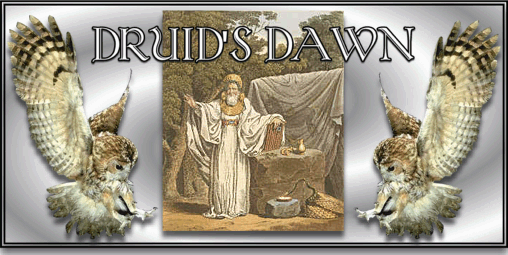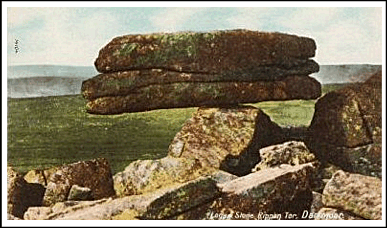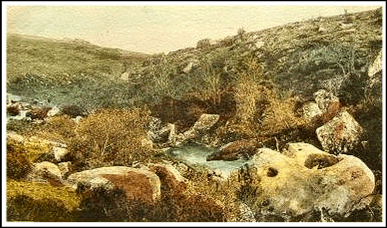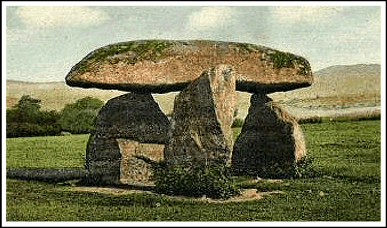
If the early antiquarians are to be believed then Dartmoor was a land of sacred oak groves, druidical temples, and places of deep mystery. Many of the stranger physical features of the moor have been said to have been the work of these ancient priests. Today, vestiges of their presence exist in place-names such as the Druid’s Chair, Druid’s Well, Druid’s Altar, Druid’s Stone, Druid Mine, Drewsteignton, Druid, and the Druidical Temple.
Probably the place most associated with Druid folklore is Wistman’s Wood, some people consider that the name derived from ‘Wood of the Wisemen’, referring directly to the Druids. Today it is still not hard to see why the dense wood of dwarf, gnarled, oak trees should have spawned legends of ancient pagan rituals amongst the early dwellers of the moor. Indeed, is not the wood overlooked by Beardown or the ‘Hill of Bards’, are not the surrounding slopes scattered with the remains of early settlements?
Take a walk up to the top of Kestor and see the huge basin that was once the font of the druids just like many of the other rock basins to be found on the tors of Dartmoor. Mrs Bray once again writes:
“It will not, I hope, be deemed a useless digression to mention what is supposed to have been the use of these rock basins. Borlase, in his Antiquities of Cornwall, informs us that they were designed to contain rain or snow water, which is allowed to be the purest. This the Druids probably used as’ holy water for lustrations. They preferred the highest places for these receptacles, as the rainwater is’ purer the farther it is removed from the ground. Its being nearer the heavens also may have contributed not a little to the sanctity in which it was held.”
Similarly, wander up many of the tor sides and see the huge logan stones that the Druid’s could spectacularly make rock with the pressure of one finger. Examples of which are ‘The Rugglestone‘ and ‘The Nutcracker’, Crossing writes:
“Formerly all rocks so nicely poised as to move with very slight pressure were thought to have been in some way connected with Druidical rites.”

Stroll down beside the river Teign as it cascades past the huge, holed, Tolmen Stone and say that was not where the ancient priests held purifying rites under the shadow of the old stone circle of Scorhill. Page writes;
“With regard to the assumed use of tolmens, we are told that they served the Druids for purposes of purification, and the wrongdoer was lowered through into the water for lustration.”

So where did this strong belief in the druids come from? Mrs Bray wrote in the late 1800’s that:
“When the Dartmoor Britons buried a chief, who was always a warrior or a king, the Druids raised a heap of stones over his grave; and sometimes a very large single piece of granite, supported upon three or four upright stones, as we see the legs support an old fashioned table; and this they called a Cromlech.”

So, as can be seen the early writers were convinced that even the stone rows, standing circles, menhirs, cairns, and cromlechs were the work of the Druids. Samuel Rowe, in his Perambulation of Dartmoor, initially considers that, “…the Druid’s had their hill altars, and sacred groves…” Page is slightly more sceptical but he writes:
“… the most we can allow is the possibility of there having been Druids on Dartmoor, the names of whose deities are perpetuated in certain spots; but that, if so, they were very inferior to the Druids of Caesar’s ‘Commentaries.’ Nevertheless, having dreamt of them so long, it is hard to give them up without a struggle, and accept the prosaic explanations of Fergusson and others, whose souls are above mistletoe, criminals, wicker cages, and id genus omne.”
Ok, sadly it’s time to dismantle the legends, starting with the place-name evidence. There are two settlements on the moor which on the face of it allude to the druids, the village of Drewsteignton, Higher, Middle and Lower Drewston and a small hamlet called Druid. In the Domesday Book of 1086, Drewsteignton was noted as Taintona or ‘Farm on the river Teign’. It was not until 1210 that the Drogo or Drew element was mentioned in connexion with the settlement, clearly this was well after the days of the druids. The Drewstons first appear in 1281 when the name was Thurwardeston or in other words the ‘tun (farm, homestead) of Thurweard’ which again postdates the Druids. The hamlet of Druid took its name from a late 18th century house name which again was well and truly after the time of the druids. This also applies to the nearby crossroads, mine, and plantations all of which have the ‘druid’ prefix. The Druid’s Stone is located in Wistman’s Wood and is more commonly known as the Buller Stone, The druid connotation has derived recently from letterboxing poetic licence insomuch as a couple of boxes were placed off of the fanciful ‘Druid Stone’. According to Crossing, “Not far from the Blackingstone is a pile of rocks bearing the name of the Druid’s Altar,” although he mentions the rocks he does not give any explanation as to why it was considered to be a druidical altar.
The next misconception is the holed stones that were thought to have been hewn by the Druids and used in their rites and rituals. It is now known that these were naturally fashioned by erosional processes. They are caused by small, abrasive stones being swirled around a depression in the rock which gradually gouges out a hole. In the case of the Tolmen Stone this process continued until the hole had been bored right through the rock. Rock basins are another product of localised weathering and are formed when weak feldspar crystals are split by the frost along their cleavages. This loosens small fragments which are later blown away by the wind thus leaving a small hollow. The process continues and gradually the hollow expands outwards and downwards. Water fills the hollow and then freezes, upon thawing more fragments are eroded which once again are blown away by the wind. Over time the hollow widens and deepens and eventually a rock basin is formed.
We then come to the idea that the many stone rows, menhirs, stone circles, and cairns were the work of the druids. This is now known to be false as the various relics would have been in-situ prior to the coming of the druids and date to the Bronze Age. The other point worth considering is that the Druids were so called ‘Celtic’ priests which is one of the most misleading terms, Celtic, when, who and where? This would more correctly date them to the Iron Age and so it is interesting to note the locations of known Iron Age hillforts and settlements on Dartmoor. Most of them occur on the edges of the moor and none of them are anywhere near any supposed druidical feature which seems strange.
As for the sacred grove of Wistman’s Wood, the Place-Name Society consider that the name derived from the dialect word wisht, referring ‘eerie, uncanny, or the Devil’. This could possibly fit with the druidical myth as any sacred grove would be considered as ‘eerie’ and all the other legends associated with the wood run along similar lines – so maybe, just maybe …
 Legendary Dartmoor The many aspects past and present of Dartmoor
Legendary Dartmoor The many aspects past and present of Dartmoor

The reason their are no books of Druid, is because
They use Epiphanies, and anyone can do it.
Park your keister next to a Oak Tree. Then meditate.
When you think you some figured out the answer to a life long mistery that’s the beginning. As sloon as you wonder how you did it the next unanswerable will be answered. After every mistry in your mind is answered you get the explanation. Yout Druid.
The Earth Mother is responsable for this. It happened to me.
My knowledge of druidism is still limited as I am still educating myself, but, what I do know is that if i visit a sacred druid place I can feel the energy of my ancestors sometimes overwhelmingly strong and other times like a very weak pulse… Then I do not doubt that druid rituals and ceromonies took place there!!!! These sacred druid places are a bit truly amazing and well worth the trek!!!!